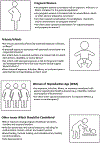Emergency Preparedness and Response: Highlights from the Division of Reproductive Health, 2011-2021
- PMID: 34919476
- PMCID: PMC10964214
- DOI: 10.1089/jwh.2021.0553
Emergency Preparedness and Response: Highlights from the Division of Reproductive Health, 2011-2021
Abstract
This report provides historical context and rationale for coordinated, systematic, and evidence-based public health emergency preparedness and response (EPR) activities to address the needs of women of reproductive age. Needs of pregnant and postpartum women, and infants-before, during, and after public health emergencies-are highlighted. Four focus areas and related activities are described: (1) public health science; (2) clinical guidance; (3) partnerships, communication, and outreach; and (4) workforce development. Finally, the report summarizes major activities of the Division of Reproductive Health's EPR Team at the Centers for Disease Control and Prevention.
Keywords: emergency preparedness and response; maternal and infant health; maternal health.
Figures
References
-
- Callaghan WM, Rasmussen SA, Jamieson DJ, et al. Health concerns of women and infants in times of natural disasters: Lessons learned from hurricane Katrina. Matern Child Health J 2007;11:307–311. - PubMed
MeSH terms
Grants and funding
LinkOut - more resources
Full Text Sources
Medical


